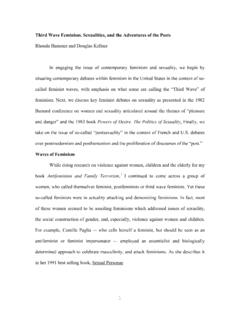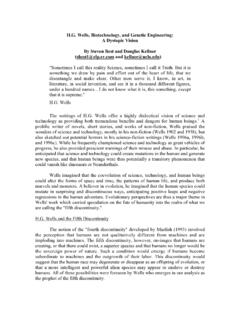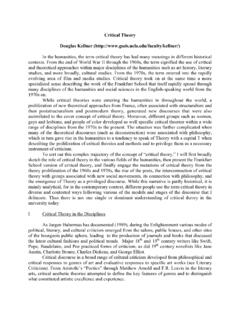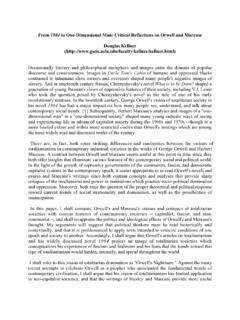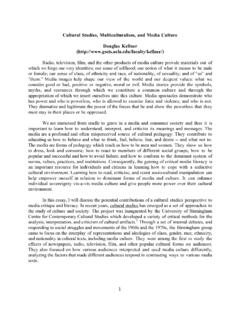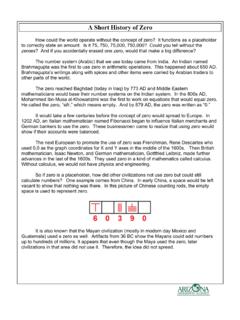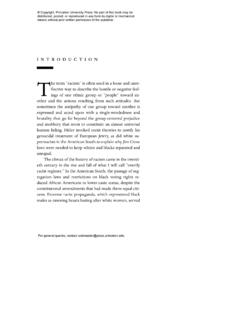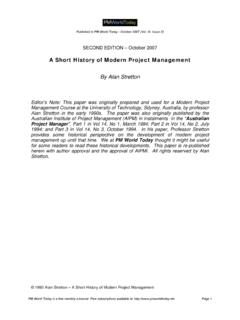Transcription of John Hartley. 2003. A Short History of Cultural Studies ...
1 1 John Hartley. 2003. A Short History of Cultural Studies . London and ThousandOaks: Sage. ix + 189 pages; $ paper; $ by Rhonda Hammer and Douglas Kellner, and Hartley opens his Short History of Cultural Studies by evoking a sense of thecontested nature of the field in the contemporary moment and the intense debates aboutits objects, scope, methods, and goals: Even within intellectual communities andacademic institutions, there is little agreement about what counts as Cultural Studies ,either as a critical practice or an institutional apparatus. On the contrary, the field is rivenby fundamental disagreements about what Cultural Studies is for, in whose interests it isdone, what theories, methods and objects of study are proper to it, and where to set itslimits (1).
2 Hartley also correctly points to the political thrust of many versions of culturalstudies, of how they connect with unprecedented personal freedoms and affluence atleast in the developed world, new opportunities in education and Cultural expression, andexpanded horizons of experience for young people, women, gays and lesbians, people ofcolor, and many other social groups and identities (2-3). Cultural Studies , Hartleyusefully reminds us, is part of an upheaval in education, in which new groups enteredhigher education, demanded innovative courses and revisions of the curriculum, andoften called for more culturally and political relevant teaching material. As a result, Cultural Studies has challenged orthodoxies since its development in Britain in the 1960sand continues to be a highly controversial and contested presents Cultural Studies as an arena of plenty and inclusiveness, signifying the multiple topics, disciplines, and methods that the project has figures as diverse as Raymond Williams and Michel Foucault, Cultural studieslinks knowledge with power and the study of culture with society and politics.
3 Moreover,as Hartley contends: Because of its position as a crossroads or bazaar for the exchangeof ideas from many directions, Cultural Studies has been at one and the same time amotley confusion of difference, and an ambitious intellectual enterprise, seeking nothingless than to rethink received truths and remake inherited frameworks of explanation. Onthe ground of difference, debate and disagreement, it has sought to build a newconsciousness (2).Within this framework, Hartley provides a generalized History and analysis ofcultural Studies within six loosely organized chapters that present six different landscapes of Cultural Studies (9ff). He argues that there can be no linear History of this postdisciplinary perspective, which is constantly expanding and drawing on newtheories and methods.
4 This idea appears to underlie much of his discourse andorganization of the six major areas of discussion which are identified as: Cultural Studiesand Literary Criticism; Mass Society; Art History ; Political Economy; Feminism,Anthropology, Sociology; and Teaching. The substantive issues of each chapter are moreadequately reflected in the chapter subheadings of each section. For example, Chapter 12(playing on George Bernard Shaw but flirting with a paternalistic sexism) is titled TheIntelligent Co-ed s Guide to Cultural Studies : From Virginia Woolf to Tom Wolfe(destination O Hare). As the oblique title suggests, Hartley s text demands a particularliteracy on the part of the reader, in areas of literature, literary criticism, politicaleconomy, British Cultural Studies , and geography.
5 The Short History demands as wellfamiliarity with leading writers associated with Cultural Studies traditions forunderstanding and appreciating the multiplicity of iconoclastic, intellectual and popularthemes and references being addressed by the well-versed and multi-disciplined Hartley claims that his book tries to underplay its author s preferences,predilections and prejudices (7), it is the author s expertise in popular media, culturalhistory, and textual analysis which provide some of the book s greatest insights,relevance, and humor. Moreover, Hartley s background as a controversial Cultural studiesscholar appears to inform much of his analyses. Associated with Cardiff University inWales and then universities in Australia, his writings and co-writings with John Fiskeprovoked major debates and critiques in the 1980s, as well as academic celebrity status,and Hartley has been a prolific and influential force within Cultural Studies since the1970s.
6 This is especially apparent in his many knowledgeable references and assessmentsof leading Cultural Studies schools and theorists (which tend to emphasize British CulturalStudies contributions and be Anglo-Oz Empire-centric in focus).Indeed, Hartley s Short History of Cultural Studies can be read as John Hartley sodyssey through the field and its sometimes-dramatic polemics and debates. Thechronicler provides Short synopses of his academic career, a list of his books, andpersonal reflections on various debates, figures, and episodes that he has experiencedwithin Cultural Studies . His concerns with semiotic and textual analysis, audienceconstruction, and the changing roles of regulatory bodies punctuate the text s discussionof various topics. The back cover of the book advertises that Cultural Studies has foundits Boswell in Hartley, a claim that may be an exaggeration, though Hartley provides atour of his university schooling, conference going, reading, and provides his constructionof various themes and contributors within Cultural Studies and related has long extolled the significance of semiotics as one of the mostpowerful components of Cultural Studies research, and grounds his interest in popularculture and theory within the context of political literary theory and Cultural History (19f).
7 Hartley also grounds Cultural Studies within the History and vicissitudes of publishing,identifying the republication of George Bernard Shaw s The Intelligent Women s Guideto Socialism, Capitalism, Sovietism and Fascism, in the accessible and inexpensivePelican books paperback form, in 1937, as the launch of the project of Cultural Studies (20). One of Hartley s main discussions traces the influence of early technologicalinnovations in publishing formats, and of editorial control on the consumption andproduction of audiences and/or readers of Cultural Studies texts. As he puts it: Thehistory of Cultural Studies can be traced via publications that addressed the free (activist)reader and the student (academic) audience (150). Hartley goes on to describe themaking of multiplicities of texts which range from print, broadcasting, film, music andadvertising to Cultural policy, tourism, flaneurism, fashion and the resistive walk of3supermodels, like Kate Moss (whose face graces the cover of the paperback).
8 He situatesthese discussions within the context of debates about Marxism, economic determinism,hegemony, governmentalism, popularization, depoliticization, textual analyses,ideological critique, audience research, anthropology, abstraction, marginality, resistance,commoditization, and globalization which have defined and continue to characterizetheoretical and practical work in Cultural concerning the nature and role of the readers of Cultural studiestextbooks take up some of Hartley s earlier positions on audience construction andprovide a provocative dimension of his History . In particular, Hartley highlights theparadoxical and shifting nature of conceptions, substance, and roles of textbooks incultural Studies . He notes that, at one level, writers and publishers of Cultural studiesimagined a community of readers and students (149).
9 These readers are not a passiveaudience but are textualized by the writing that addressed them (149). The History ofcultural Studies textbooks (including his own?) for Hartley includes the reading of majorpublished Readers to trace shifts in Cultural Studies research, writing, and Hartley explains, the original audience for Cultural Studies Readers waspresumed to be adult, probably male, politically radical or already andactivist in some political pursuit (150), presumably in the 1960s and 70s. The readersfor these textbooks, he argues, were seen as primarily intelligent laymen, whereas morecontemporary audiences for texts are identified as people working or studying in theacademy. He goes on to argue that there was a shift in the actual or perceived readershipof Cultural Studies to an internationalist, juvenated, feminised, multi-race,multiculturalised and institutionalised student audience who were not presumed to beactivist, but were encouraged to radical activism (ibid.)
10 The earlier readers, he asserts,were considered to be the equals or co-subjects of the writer, while later on a hierarchy ofpower was imposed, whereby the writer became the all-knowing authoritative subject,perhaps like Hartley whose Short History presupposes vast interdisciplinary knowledgeand appears to relate this commoditization with the advent of Americanuniversity Cultural Studies programs, as well as the initiation of academic conferenceswhich published textbook Readers, based on discussions and papers presented at theseevents. His critique of these tendencies of Cultural Studies to over-privilege the supplyside and undervalue the demand side is curious given that he was part of a highlysuccessful and leading pedagogical series on Cultural Studies , published by Methuen NewAccents series, which was edited by his mentor Terry Hawkes and featured writers fromCardiff, in the late 70 s and 80 s and a later series by Methuen in Studies inCommunication, and he himself is obviously continuing to engage in Indeed, Hartley s Readers were highly influential in colleges anduniversities, especially in the United States, although, as Graeme Turner notes.
